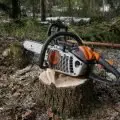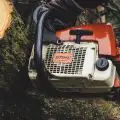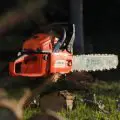Nothing is worse than anticipating a nice workday only to learn that it will start later than expected due to chainsaw maintenance issues. No matter how simple a chainsaw is to maintain, odds are it will ultimately have issues at some point.
Most of us count on our chainsaw to function constantly and whenever we need it to because of its durability. What do you do if your chainsaw won’t idle but you need to get the job done?
Your chainsaw should be allowed to idle properly for some time after starting before you finally activate the clutch, which is in charge of moving the gears and sprockets that spin the chain.
A two-cycle engine may occasionally struggle to maintain operation, which could result in the engine shutting down while it is not in use. Different factors can cause a chainsaw to not idle.
In this article, we will go over the causes and the required actions to take if your chainsaw won’t idle!
Table of Contents
- Why Won’t My Chainsaw Idle?
- Chainsaw Won’t Idle Causes
- How to Fix Chainsaw Won’t Idle Issues
- FAQs (Frequently Asked Questions)

Why Won’t My Chainsaw Idle?
This could be due to a number of various factors. If the air filter is clogged, the engine may run on an air-fuel mixture, which may reduce power and provide a low throttle response. It’s important to get the right air-fuel ratio, visit our Fuel Oil Ratio Mix Guide to learn more.
When you add too much oil to the gas-oil fuel mix, the spark arrestor may also become clogged. This would result in a significant amount of unburned material because oil burns at a much higher temperature than gas. The spark arrestor will become blocked by the soot created, obstructing the free flow of exhaust gases.
Another factor could be spark plugs with corroded electrodes because, as you are aware, a fire cannot actually start without a spark. Even if there is a spark, the fuel mixture will not burn completely because of the carbon buildup surrounding the electrodes making the spark too weak. For this reason, the majority of chainsaw manufacturers advise replacing the spark plug every 100 service hours.
Additionally, you might want to examine the fuel filter and fuel line within the gas tank. The soft rubber tubing that typically transfers fuel from the tank to the carburetor may occasionally deteriorate as a result of the ethanol (found in less expensive gas).
You can shine a light into the tank after it has been emptied to look for any fractures or holes in the gasoline line. If they exist, it is time to replace them. Since they are rather inexpensive in any case, you might as well replace the gasoline filter while you’re at it.
The chainsaw will run lean if the gasoline line has corrosion because it will allow too much air into the tank. This merely indicates that the chainsaw will only operate at a standstill for a little period of time before turning off entirely.
Chainsaw Won’t Idle Causes
The two most frequent causes of a chainsaw not idling are a dirty air filter and an idle screw out of adjustment. All likely causes include:
- Clogged air filter
- Idle Screw out of adjustment
- Contaminated gas
- Faulty plug
- Vacuum leak
- Faulty carburetor
- Clogged muffler/spark arrestor
With a chainsaw that won’t idle, handling timber is not pleasant. Even without needing to balance the throttle to prevent stalling, using a chainsaw is risky enough.
How to Fix Chainsaw Won’t Idle Issues
There is no need to adjust the idle if your chainsaw starts readily and runs without any problems. If it does, then it is functioning properly. However, if the chainsaw is unresponsive or difficult to start, this may be a sign that the fuel and air mixture is problematic.
If it replies for a small period of time, falters, and ultimately shuts off, there is a problem with the idle. Last but not least, if your chainsaw sounds good but loses power when working under a load, the issue can possibly be idling. Here are some solutions for issues with idleness.
Clean the Air Filter
Given how frequently the air filter becomes dirty, this is a logical place to start. As you are already aware, chainsaws produce a lot of dust and debris, and some even include an air-direction system that directs air to the carburetor.
When this occurs, the air filter is often left to collect all the particles. All contemporary chainsaw models feature tool-free air filter covers that make it simple to access the filters. Depending on the manufacturer, some chainsaws have fine mesh screens while others have a fabric or foam filter.
The air filter should be cleaned using compressed air, but because not everyone has access to a compressor, a simple workaround would be to tap it against a solid surface to remove all the particles. After that, you can clean it up with a clean rag or a bristles brush.
Varying filters frequently have different chainsaw maintenance recommendations, but once you tap off the excess dirt and debris from them, the majority of them are simple to clean with warm, soapy water. Due to its durability, most air filters normally survive for a long time.
However, you’ll almost certainly need a new filter the instant you see a hole in it or notice a lot of material entering the system. All attempts to modify your idling may be difficult if an air filter becomes clogged. After five hours of operation, air filters should be cleaned.
Locate the Idle Screw
The carburetor on all gas chainsaws frequently has three adjustment screws that are accessible without removing any covers. The adjusters won’t actually be visible to you; instead, you’ll only need to find the proper access port and insert the appropriate adjusting tool.
The low throttle adjuster is the initial adjustment, which is designated with the letter (L) on the body cover. The high throttle adjuster (high-speed screw), which is the second, is identified by the letter (H).
Since these two adjusters are paired and pre-set from the factory, adjusting them frequently calls for a specialized tool. Yes, they can be modified, but doing it successfully requires skill.
The idle screw adjuster, denoted by the letters L, T, or LA, is the third adjustment and is frequently positioned just above or below the other two. The third adjustment that needs to be adjusted is this one.
For this, all you need is a flat screwdriver or an item that can easily fit through the side cover’s hole. Despite your desire, it’s not a good idea to remove the air filter in order to gain access because it should remain in place. The entire purpose of the access ports is for this.
Tweak the Carburetor Idle
The idle screw is frequently found on the left. To be on the safe side, it is preferable to discover the proper screw or screws to adjust by consulting the owner’s manual or searching online for your specific make and model. The principle is often the same whether you adjust one screw or three different screws.
One-Screw Idle Adjustments
Start your chainsaw and keep a flat-head screwdriver nearby so you can quickly find your starting point. Because the T-head screws are quite delicate, you should use your flat screwdrivers in increments of no more than a quarter turn while taking mental notes as you go.
Watch out for variations in the engine’s behavior while you are throttling and while it is idling as you spin the screw in either a clockwise or counterclockwise direction.
You’ll need to pause for a while if your chainsaw is using too much fuel and running rich if it doesn’t stop spinning during idle or if it produces smoke. On the other hand, if it spins too slowly or hops around while idling, it is receiving insufficient fuel and requires more. When the saw runs lean or rich, always keep track of where the screw is.
Three-Screw Adjustments
When changing the high-speed performance screw on three-screw carburetors, you should be cautious because they might be challenging to tune. Find the “LA” screw before adjusting. The general idle speed is controlled by this screw, and adjusting performance is quite similar to that of the single-screw carburetor adjustment mentioned above.
As with the single screw, start by adjusting this screw. Then, adjust the “L” screw. High-speed adjustment is denoted by the letter “H” screw. This screw is highly important because it can seriously harm the engine if it is set too richly or too lean. It is advised not to turn this screw more than 14 turns in either direction.
Find a balance between the lean and rich points by turning the screws to reveal where they are. A timing screw shouldn’t ever need to be fully opened or closed to the maximum or minimum position. You should probably take the chainsaw to the shop for maintenance if this occurs.
Here are a couple of YouTube demonstrations on the topic, the first being on a Poulan chainsaw.
More chainsaw troubleshooting:
- How to Port a Chainsaw
- Are Chainsaw Bars Interchangeable
- How to Unflood a Chainsaw and Start It Once Flooded
FAQs (Frequently Asked Questions)
How do you fix a chainsaw that won’t stay running?
One of the most frequent causes of a chainsaw that won’t start or continue to run is clogged carburetors. It’s best to change the fuel and fuel filter by removing the fuel cap before using the chainsaw again if it hasn’t been used for a while. Check the fuel lines after draining the fuel tank.
Why does my chainsaw die when I give it throttle?
Check to see if the idle screw (I) and low-speed screw (L) are properly adjusted if your chainsaw dies after you give it gas. Find the ideal position where applying the throttle doesn’t cause the engine to bog down. In addition to the screw setting, make sure the spark plug is in good working order and that the carburetor and fuel jets have been properly maintained.
How do you adjust the idle on a chainsaw?
Turning a T-head screw is the only way to change a chainsaw’s idle. The idle screw is often on the left side of chainsaws that are right-handed. To be sure you’ve located the correct screw or screws to adjust, it’s recommended to consult the owner’s manual or conduct an online search for your make and model. Either one screw will need to be adjusted, or three, but the idea is the same in both cases.





